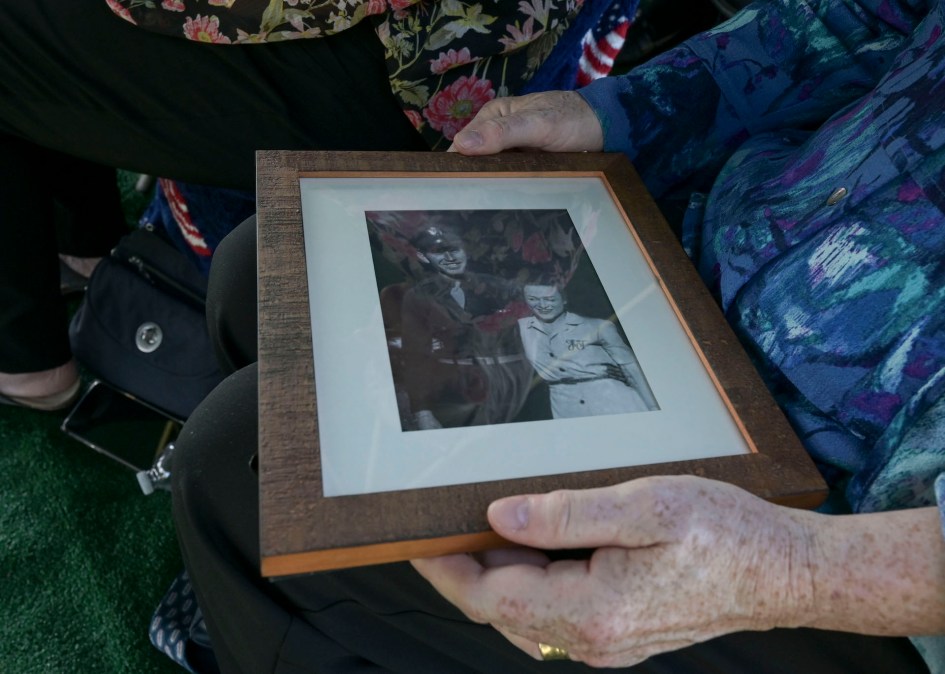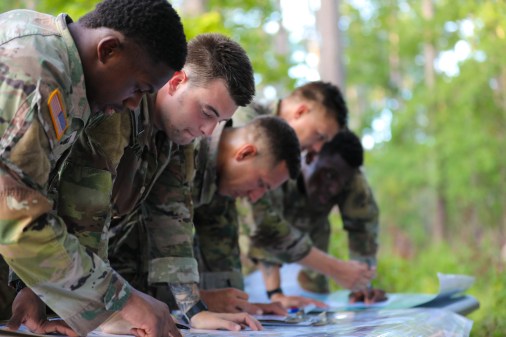How digitization is delivering real-world impacts at the Defense POW/MIA Accounting Agency

The Defense POW/MIA Accounting Agency (DPAA) — and its international research partners, including Russia and China — are increasingly using digitization technologies and AI to accelerate and improve upon their sprawling searches through decades-old materials to identify individuals who remain missing from past conflicts involving the United States, senior officials recently told a small group of reporters.
“It’s not only at DPAA, but worldwide. This helps us because it opens up records,” Darla Stencavage, chief of the agency’s Joint Commission Support Division and U.S.-Russia Joint Commission on POW/MIAs said.
Stencavage joined DPAA Director Kelly McKeague and other senior leaders for a media roundtable in Arlington last week, in advance of the agency’s Korean War and Cold War Annual Government Briefs event. More than 400 family members of still-unaccounted-for Americans signed up to participate in this round of briefs.
Ahead of the two-day function, the officials shared new details with the press regarding their current but steadily expanding caseload, recent and desired international archival exchanges, and how software and other technology innovations are supporting their real-world recovery and identification pursuits.
“The Department of Defense has what we view to be a unique mission, and that is to account for the missing from past wars. Statutorily, we are bound by World War II through the Persian Gulf Wars, but there’s also a secondary component to the mission — and that is to connect and communicate with families. And so we gather the families six times a year,” McKeague said. “In this case, we bring them to Washington, as we do each year. And these are the Korean War [and] Cold War families who are still waiting for the ultimate answer, which is obviously the return of their loved one [who has been] missing since 1950 through ‘53.”
Digitization helps
DPAA’s overarching mission is to bring closure to American families and the government by recovering remains and resolving cases of military personnel and others who did not return from previous wars.
According to recent estimates shared with DefenseScoop, there are more than 72,000 missing from World War II, more than 7,500 missing from the Korean War, 126 missing from the Cold War and more than 1,500 missing from the Vietnam War.
DPAA assesses around 39,000 of those can be recovered, while the others are considered to be largely deep, at-sea losses.
Inside the agency, experts are tasked with a wide range of responsibilities, many of which are interdisciplinary in their nature. Some analyze historical records, interview witnesses and uncover other resources to gather information about those who are missing. They and others engage with the agency’s international counterparts and the nearly 18,000 active families DPAA is in communication with. Officials also conduct field investigations and recovery operations all over the world, across terrestrial and underwater sites. Further, they often use DNA matching and various scientific analyses to identify remains that they find.
“We are one of the few organizations in the entire department that has the authority with which to establish private partnerships. These are universities, [and non-governmental organizations or] NGOs — and we do it with great abandon. We have 106 of these. We utilize them to build out our capacity and capability,” McKeague told DefenseScoop.
DPAA officials understand the need to practice what he referred to as “tried and true methods” in science and anthropology that AI could never fully replace. However, they also recognize the power that emerging capabilities provide for their pursuits.
Offering an example of how the agency is leveraging advancements its partners are making with AI and machine learning to drive its own research and recovery efforts, McKeague pointed to work one team has been doing with the Scripps Institution of Oceanography at the University of California, San Diego.
“They have AI and machine learning-based technology using little — these things are small — they’re robots, essentially unmanned, and 12 of them each have a unique sensor on it. They’re all dropped in the water. They go back and forth across the ocean floor. Every time one sensor picks up an anomaly, the other 11 come and map it out. What would take traditional diving weeks to survey, it was done three-dimensional in a week-and-a-half,” McKeague said.
DPAA’s Korean War Chief of Research Dr. Dawn Berry noted that officials additionally combined some of that data captured with Geographic Information System (GIS) technologies to help geo-locate and visualize what could be deep-sea air losses and possible remains.
The agency is also applying AI to narrow down the scope of archival records that historians and researchers have to evaluate and bolster nonstop records digitization activities.
“If you think back to the old days where people were looking through microfiche on their own, items could have been missed. And now, with digital digitization [techniques], we are able to do searches and find things we might have overlooked in the past. And the more and more things are digitized [anywhere], it helps us. And then within DPAA, we are digitizing our records too, and that helps us to compare information,” Stencavage told DefenseScoop.
DPAA supervisory forensic anthropologist Dr. Jennie Jin pointed out that sometimes digitization involves tedious and mundane modernization efforts that take time to pay off.
“It’s things that often don’t get the spotlight — like our dentist spent like three years digitizing all Korean War dental records. It takes more than just feeding the scanner, because you have to look at it and then enter it into software, right? And then scan the paper. Scanning the paper is easy, but moving that information into a database so we can use it [is harder]. And we actually were able to make a quick ID thanks to the years of effort,” Jin explained.
A separate digitization-related project popped up recently that sparked an interdisciplinary team of experts to jump into action.
Officials at a military archives facility in St. Louis alerted DPAA leadership that they had come across a collection of individuals’ chest X-rays from World War II that they were preparing to destroy.
“Everyone’s clavicles are unique — like a fingerprint,” Berry noted. “So we joke that there’s no such thing as a historical emergency, except they called … and they said, ‘Hey, we have these radiographs. Do you guys need them?’ And someone, literally — one of the historians — went on a plane the next day to retrieve them. And then some really, really innovative scientists figured out what to do with them and what the next steps would be.”
Jin added that now that those images are at DPPA’s lab in Omaha, Nebraska, for digitization, experts are looking to develop software that can automatically match the records to other X-rays that are already in the agency’s archives for identification or other purposes.
“It’s not that easy. We’re not there yet. But if we have 10 candidates for one set of clavicles and vertebrae, then we can actually use Adobe [commercial products] to look at all different things. And then the last step would be to put those two together, superimpose, to see if they match. And [sometimes] they match beautifully. If it’s a match, it’s pretty unique to each one of us. So that’s a very exciting technology that we use,” Jin told DefenseScoop.
People-to-people ties
DPAA officials currently operate in 46 countries, including some of America’s past adversaries and current competitors.
“So China came to us and said, ‘This [work] is separate. This is humanitarian, [not political]. We will help you on this, while we deal with tariffs, while we deal with [tensions in the] South China Sea, while we deal with all of these other points of friction.’ But China cooperates readily,” McKeague said.
The U.S. and China have engaged in records and research exchanges since the mid-1990s. During an archival exchange in Beijing last summer, senior officials let DPAA staff members into the People’s Liberation Army archives building for the first time.
“We had our meetings at that building, and they provided documents to us related to Korean War and Cold War cases, and then we also asked questions about broader cases — that also helps us operationally plan in China. So we had several missions and activities in China last year. We had a PDSS, a pre-deployment site survey, in January. In the summer, we also had an excavation and we had an investigation in Dandong, [China], around the North Korean border,” Jin said. “There’s also been a very, very major development for a World War II case that the excavation that we did resulted in an identification earlier this year.”
Separately, DPAA has been cooperating with Russia for more than three decades on a bilateral commission, through which the two nations share information and data that could help each determine the fates of those that remain missing.
“And that’s not just for our missing on those territories. Russia was our ally during World War II, and our adversary during Vietnam, Korean and Cold Wars. And we’ve been able to get information documentation from them that they have that allows us to help develop leads and progress cases,” Stencavage said.
She confirmed that while the agency had not had communications on a regular basis with Russia for the past year-and-a-half, those just recently opened up again, and U.S. officials have been allowed back into Russian archives.
“As part of the agreement, they have a person here in the United States that goes into the National Archives, and they did not have a visa, so they had stopped our access to their archives as a reciprocal action. And their archivist was just given a visa last month, so we were allowed access again,” Stencavage told DefenseScoop.
Still, DPAA could carry on conducting some research projects associated with Russia during the pause, even without access to those physical archives.
“Because more and more information is getting digitized. So, my group worked by doing a search of the library’s online information, because new things will come up, or things that you might have missed before in the past you could get access to. And so we actually found a newspaper article that identified who was the country that shot down an aircraft — it previously wasn’t known. So that doesn’t account for any of our Cold War … losses, but it gives a lead to another researcher so that they can pursue that and get more information,” Stencavage said.
Offering another example, McKeague added that after the Vietnam War, even in the midst of economic sanctions, trade embargoes and all sorts of other penalties, the U.S. worked directly with the Vietnamese communist government to recover and identify missing military personnel.
“Literally, Vietnam was persona non grata to the United States — but it was this mission that opened the doors to what is now a prosperous, stable, peaceful country in the region,” McKeague said.
However, unlike DPAA’s recent progress with those partners, diplomatic uncertainty with the communist regime in North Korea have largely complicated America’s retrieval and recovery efforts with that nation over the years. DPAA estimates that nearly 7,500 American military service members are still unaccounted for from the Korean War — including approximately 5,300 whose remains are thought to be inside North Korea.
“[Their] families are deeply frustrated. The families continue to be disappointed, simply because the cooperation from North Korea has been episodic,” McKeague noted.
He and the other officials at the roundtable emphasized that the Trump administration is open to reestablishing dialogue with its North Korean counterparts on topics related to DPAA’s research and recovery endeavors.
“What’s frustrating for us is that we look at this as a humanitarian effort. The 46 countries we work in all cooperate — with some being former enemies [such as] Japan, Germany, Vietnam — and everybody looks at it as cooperation. That is part of our responsibility. It’s part of strengthening people-to-people ties. But the North Koreans are the only country that doesn’t see it as other countries do,” McKeague said. “I mean, even today, despite the global tensions between the United States and China, we have a team in China that’s been operating there for weeks. They are ironically looking at three Korean War air losses in Liaoning Province, which borders North Korea.”





